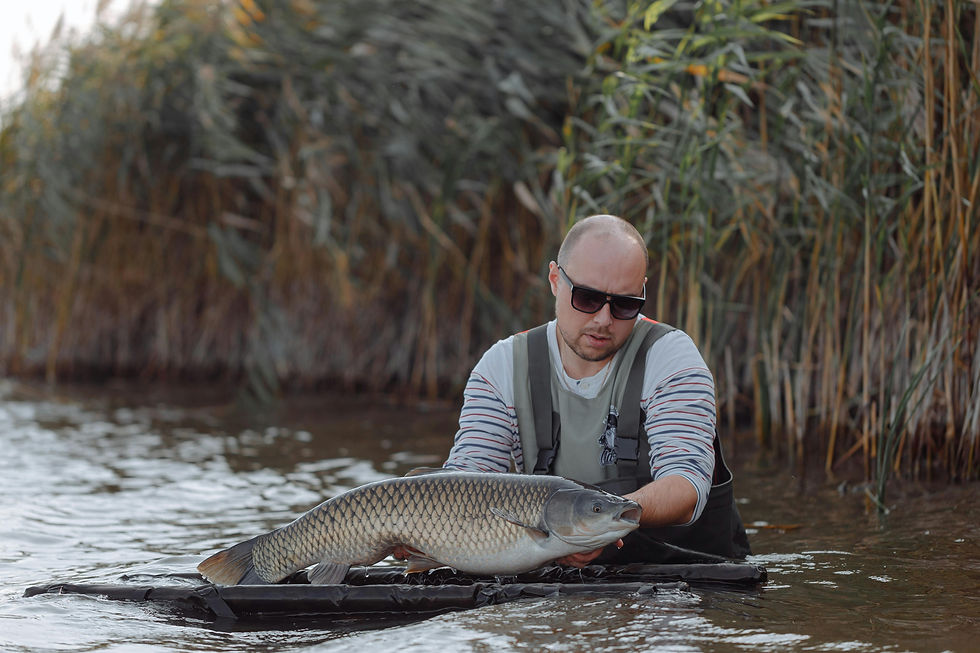Why Bulgaria’s Big Fish Are Disappearing
- sulevaivelina
- Aug 11
- 3 min read
Bulgaria’s waters — from the Black Sea coast to the mighty Danube and the country’s network of rivers — once teemed with large, iconic fish. Species such as turbot, catfish, carp, and several types of sturgeon were a source of livelihood, cultural pride, and ecological balance. Today angler`s say, these giants are increasingly rare, their decline a warning sign of deep ecological stress.

Recent studies reveal that this is no single-cause problem. Overfishing, pollution, invasive species, habitat degradation, and climate change all interact to threaten the survival of big fish in every major habitat.
Different Habitats, Shared Challenges
Black Sea
The Black Sea has historically supported thriving populations of large fish like turbot, bluefish, and sturgeons. However, decades of industrial pollution, eutrophication, and heavy fishing pressure have severely depleted these stocks. Bycatch in fisheries targeting species such as the invasive Rapana venosa disproportionately removes juvenile and breeding-sized individuals, making population recovery slow and uncertain.

Danube River
The Danube — Europe’s second-longest river — is a critical migration route for sturgeons and other large fish. In Bulgaria’s stretch of the river, habitat fragmentation from dams, dredging, and bank reinforcement has cut off access to spawning grounds. Overfishing, both legal and illegal, remains a persistent problem, while pollution from upstream industrial and agricultural sources degrades water quality.

Other Rivers (Maritsa, Iskar, Struma, etc.)
Inland rivers once hosted large native fish such as catfish, pike, and even migrating sturgeons. Habitat alteration, sand and gravel extraction, and pollution have greatly reduced these populations. Climate change is also shifting river flow patterns and temperatures, further stressing species that require cold, oxygen-rich waters.

Spotlight: The Vanishing Atlantic Sturgeon (Acipenser sturio)
The Atlantic sturgeon — known in Bulgarian as Немската есетра — is one of the most striking examples of decline. Reaching up to 3.5 meters in length and 320 kilograms in weight, it is a migratory species that spends most of its life at sea but enters large rivers to spawn. Historically, its range included the Black, Aegean, Adriatic, and Mediterranean seas, as well as much of Europe’s Atlantic coast.

In Bulgaria, this species once migrated up the Danube and even reached the Maritsa River — with records of individuals making it as far as Plovdiv in the early 20th century. By the 1940s, ichthyologists were already warning that populations were nearly destroyed in most of Europe. In the Black Sea basin, annual catches were down to around 100 individuals.The last recorded capture in Bulgaria was in 1963. Today, experts believe it is extinct from the upper and middle Danube and likely gone from the Black Sea region as well.
The species’ reproductive biology made it especially vulnerable:
Late maturity — males at 7–9 years, females at 8–14 years
Short spawning window — April–June, requiring clean, fast-flowing, stony-bottom habitats
Low spawning frequency — even a long-lived female could spawn only 4–5 times in her life
Specialized diet — crustaceans, worms, mollusks, and fish, meaning any disruption in prey availability had cascading effects
Once lost, such a species is extremely difficult to restore — a cautionary tale for other large fish still holding on.
Main Drivers of Decline
Overfishing and Bycatch
Intensive fishing, often targeting the largest individuals, reduces breeding stock and genetic diversity. Bycatch further worsens the situation, especially when juvenile big fish are removed before they can reproduce.
Environmental Stressors and Pollution
Heavy metals, microplastics, nutrient overload, and fluctuating oxygen levels undermine fish health. In the Black Sea and Danube, pollution comes from both local and distant sources, meaning even good local management cannot fully shield these ecosystems.
Invasive and Non-Native Species
Introduced fish compete with or prey on native species, spread diseases, and sometimes hybridize, eroding unique genetic lineages. In some cases, these impacts are delayed but irreversible.
Habitat Loss and Climate Change
Loss of spawning grounds, altered river flows, and warming waters reduce suitable habitats. Climate-driven changes in oxygen levels and water chemistry add further stress, limiting recovery potential.

Big fish are more than just impressive catches — they are keystone species, shaping ecosystems and supporting livelihoods. Their decline is both an ecological and socio-economic loss. Without urgent, coordinated action — from enforcing fishing regulations to restoring habitats — Bulgaria risks losing more of these aquatic giants, just as it lost the Atlantic sturgeon.



Comments